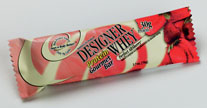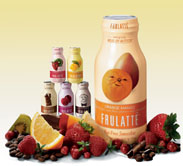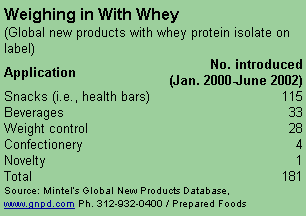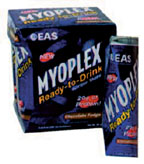
All About Whey
Carlsbad, Calif.-based Next Proteins International's mission is to wow the world with whey. Whereas many companies formulating with whey ingredients rely solely on the ingredient statement to convey the inclusion of whey, Next Proteins is far from shy when boasting about the whey protein content of its new product lines: Designer Whey Protein Gourmet Bars and Designer Whey Protein Blast drinks.Product labels describe whey as “The Best Protein Source. Does the Body Better.” Next Proteins' proprietary Designer Whey Protein (DWP) blend contains whey protein concentrate, hydrolyzed whey protein concentrate and whey protein isolate (WPI) obtained using unique pressure-driven ultra-filtration technology. WPI fractionated by pressure-driven ultra-filtration keeps intact components such as glycomacropeptide, which are said to aid dieters in curbing and controlling their cravings, as well as the anti-bacterial lactoperoxidase and the anti-microbial, anti-inflammatory, immune system-boosting fraction lactoferrin.
Next Proteins has invested close to $3 million in research and clinical testing of its proprietary whey ingredient blend and claims, “All of our products provide great-tasting ways to increase lean muscle mass, decrease body fat and provide muscles the fuel they need to recover from strenuous activities, in addition to many other body and health benefits afforded by whey protein.”
Each 75g protein bar is packed with 30-33g protein, 6-9g carbohydrates and 7g or less of fat. Unlike other protein bars that use caseinate as the main ingredient, DWP bars are caseinate-free, resulting in a clinically proven six-times greater improvement in muscle performance, says the company. Bars come in varieties such as Chocolate MaltedMUSCLES, Lemon CRUNCHES and Perfect ABSberry.
The DWP drink more closely resembles a sports drink than a protein shake. Like traditional sports drinks, it contains electrolytes, but is not loaded with carbohydrates. In fact, a 20-oz. bottle contains only 2g of carbohydrates. Flavors are Orange PassionFIT and Kiwi STRONGberry. Each flavor comes in two strengths: 17g protein and 34g protein.
www.nextproteins.com

Friend or Foe?
Though many dairy processors remain resistant to soy, others recognize that soy and milk ingredients can work in harmony. Such is the case with Frulatté Foods Co., Oakland, Calif., with its new six-flavor Frulatté line of fat-free smoothies. Sold in grocers' refrigerated dairy cases, the drinks are retorted in glass bottles and distributed at ambient temperature, though they are sold refrigerated. Promoted as a meal-in-motion, Frulatté is designed for health-conscious people with active lifestyles.Each 10.5-oz. bottle delivers 50% of the DV for calcium—along with 10g protein, five of which are WPI. The WPI contributes calcium to Frulatté, with each serving containing as much calcium as 1.5 cups of milk, which is 50% of the DV.
The WPI also provides Frulatté with a creamy appearance and mouthfeel, much more than a soy protein-only beverage could achieve. Except for the Mocha Cappuccino flavor, Frulattés do not contain lactose, making the drink appealing to the millions of lactose-intolerant Americans who consume soy-only beverages.
www.frulatte.com

Low Carb, High-Protein Crunch
In efforts to appeal to the more than 50 million carbohydrate-counting dieters, Breakthrough Engineered Nutrition, a subsidiary of Go2Pharmacy Inc., Largo, Fla., blends WPI with soy protein isolate to make a low-carbohydrate, high-protein sweet snack food, which puts crunch back in these dieters' lives.Created by a team of six nutritionists, Lean Protein Bites look and crunch like Cocoa Puffs yet, serving for serving, contain as much protein as canned tuna. Made using a patent-pending technology that makes protein crunchy, each 1oz.-serving delivers 120 calories, 14-16g of high-quality soy and whey protein, and only 1-2g of carbohydrates. Lean Protein products contain no glycerine, a hidden carbohydrate that often is used in many low-carbohydrate bars and snacks.
According to the company, consumers following a low-carbohydrate or low-sugar diet should eat Lean Protein Bites in between meals to curb hunger and to keep their metabolism burning. For those on a muscle-building program, they should be eaten as a lean protein supplement between meals to prevent muscle breakdown, as well as after a workout or before bedtime to help speed muscle recovery and growth.
www.leanprotein.com

Sidebar: Milk's Valuable Component
It takes 1,000lbs of milk to obtain 6lbs of whey protein, an up-and-coming value-added ingredient that provides both functionality and nutrition to food formulations, as well as contributes to overall health and well-being when consumed on a regular basis. This is a different approach to looking at a product that has traditionally been considered a useless by-product of cheesemaking. In fact, for years, cheesemakers struggled with what to do with the 90lbs of whey that were generated with every 10lbs of cheese produced.Today, whey ingredients are used not only for their solubility, water binding, emulsification, gelation, whipping, foaming and viscosity development properties, they are used in wellness foods for their energy-enhancing, muscle-building, immune system-boosting properties. A wealth of scientific research has proven that whey protein has the highest biological value (BV) of any protein. Biological value measures protein power and efficiency with which your body uses protein. The Whey Protein Institute's website gives a biological value of 100 to whey protein, 80 to casein and 74 to soy protein concentrate.
Whey protein isolate essentially is a dried, concentrated form of whey. Through a variety of physical separation techniques such as dialysis, filtration, ion exchange and precipitation, non-protein constituents such as moisture and lactose are removed from whey, resulting in a white to cream-colored powder. WPI contains 90% or more protein, making it an excellent ingredient for protein fortification of foods and beverages. It gives clear suspensions over a wide pH range and has a bland flavor. Typical WPI specifications are 92% protein, 4.5% moisture, 1.0% fat and 0.5% lactose.
In recent years, hydrolyzed WPI ingredients have made their way into the food and beverage formulation world. Researchers have been investigating how hydrolyzed WPI could help the more than 50 million U.S. adults suffering from hypertension, an independent risk factor for cardiovascular disease. Certain hydrolysis processes have been shown to release angiotensin converting enzyme (ACE), inhibitory substances from whey protein. Preliminary research results suggest these bioactive peptides inhibit the ACE enzyme from catalyzing the process that causes hypertension, thereby lowering blood pressure.

Sidebar: Going Global
aGolden, Col.-based EAS Inc., has rolled out a variety of new items containing WPI to overseas markets. In South Africa, Myoplex Deluxe Nutrition Shake is an 83g foil pouch containing a weight control drink mix to be stirred into water. The mix is made using the company's proprietary MyoPro, which is a blend of WPI, milk protein isolate, calcium caseinate, sodium caseinate and egg albumin. A single serving provides 300 calories, along with 42g of protein.
The United Kingdom now has Myoplex ready-to-drink 99% fat-free shakes made with a protein blend of WPI and soy protein isolate. This refrigerated drink is said to build up muscle tissue and provide the body with energy for peak performance during sports and fitness.
www.eas.com
Links
- Whey Protein Institute's website on the benefits of whey
- Sponsored by a supplier, information on hydrolyzed WPI and its anti-hypertension effect
- Dairy Management Inc.'s dairy ingredient application website
- Nutrition forum about dairy components
- California Dairy Research Foundations' educational website on whey ingredients
- U.S. Dairy Export Council's whey ingredient monographs